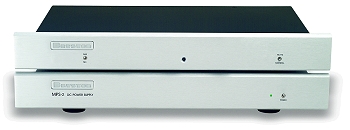Introduction
With vinyl experiencing such an incredible comeback over the past few years, so have phono preamplifiers, a.k.a., phono stages. They are required because the output of a phono cartridge is so low – on the order of 0.3 mV to 5 mV – that the inputs of preamplifiers that don’t have phono stages can’t amplify the signal enough for the power amplifier down stream. Mass market receivers still have phono stages (they never really went away), but high end two-channel preamplifiers tend only to offer the phono stage as an optional card that would be installed at the factory. For the preamplifier that does not offer that option, an outboard phono preamplifier is the answer, and there are plenty of them out there to choose from. The current review is on the Bryston BP-1.5, which is a solid state phono preamplifier that handles both MM and MC cartridges.
Although the BP-1.5 is an outboard preamp, it requires a separate power supply, the MPS-2. Fortunately, the MPS-2 has several output connections that will supply power to more than one Bryston product, such as the BP-26 preamplifier.
Specifications
- Design: Solid State Phono Preamplifier
- Inputs for MC and MM Cartridges
- Variable Capacitance Loading for MM Cartridges (External Dip Switches)
- Variable Gain Settings (Internal Dip Switches)
- MFR: 20 Hz – 20 kHz, +1, -0.05 dB
- Maximum Output: 5 Volts
- THD+N: 0.005%
- Noise: – 80 dB
- Dimensions: 1.75″ H x 17″ W x 7.2″ D
- Weight: 5.1 Pounds
- MSRP: $2,750 USA (Requires MPS-2 Power Supply; $1,500 USA)
- Bryston
The Design
The front panel of the BP-1.5 only has an on/off toggle and mute toggle. The rear panel has a pair of RCA inputs and a pair of RCA outputs. There are four dip switches, each of which can be turned on or off, giving several combinations of capacitance loading for MM cartridges. The maximum capacitance load is 188 pF (pico-Farads). There is a toggle to select whether you are using an MM or MC cartridge. Gain is set internally by moving some jumper connectors. The available gain for MM cartridges is 35 dB or 41 dB, and for MC cartridges, 51.5 dB, 57.5 dB, or 63.5 dB. The gain setting is determined by the output of your cartridge.
Shown below is a diagram of the rear panel dip switch positions to give the various capacitance loading with MM cartridges.
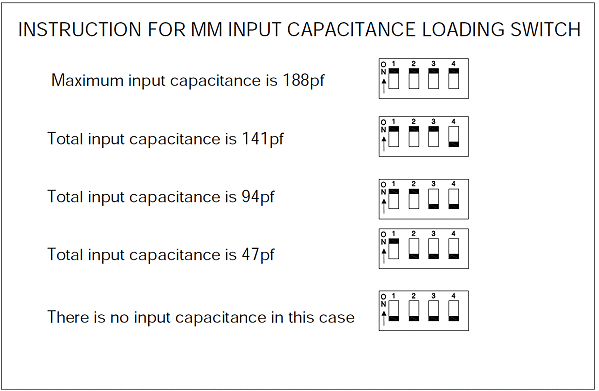
The BP-1.5 is connected to the MPS-2 power supply by a six-pin cable that plugs into one of the four available power supply outputs, shown below.

In Use
I tested the BP-1.5 using a VPI HR-X turntable with Sumiko Blackbird MC cartridge, Lamm LL1 preamplifier, Classé CA-M600 monoblock power amplifiers, and Carver Mark IV ribbon speakers. Cables were Emotiva and Marc Audio.
When one thinks of classic jazz, John Coltrane immediately comes to mind. This Blue Note release typifies his incredible skills, and they come across beautifully with the BP-1.5. The quintet includes Coltrane on tenor sax, Paul Chambers on bass, Kenny Drew on piano, Curtis Fuller on trombone, Lee Morgan on trumpet, and Philly Jo Jones on drums. I listen to cymbals in particular when evaluating vinyl-related products, not only because I am a drummer, but cymbals are difficult to reproduce without getting an overly sibilant sound to them, and the BP-1.5 maintained a very clean sound.
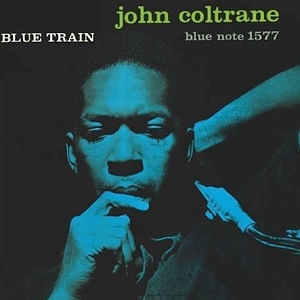
Here is another famous album, also on Blue Note, with several artists who at one time or another, had their own bands. In this case, it is Cannonball Adderley (saxophonist), and it was Adderley’s albums that got me interested in jazz when I was in high school. The wetness of the sax reed (the mouthpiece has a reed that produces the sound, and it has to be wet to work properly), as well as Blakey’s cymbals had a sheen that was very impressive with the BP-1.5.

Intensity (Fantasy) was one of saxophone artist Art Pepper’s best albums. He incorporated some of the improvisational style of pioneer John Coltrane, yet maintained harmonic melody lines. The BP-1.5 put Mr. Pepper just across the room from my easy chair. The sound staging was perfect. It’s great to have a jazz ensemble sound like they are (almost) actually there, and you can listen to them sitting in just your underwear. Pepper died at age 57, most likely due to his drug use, and he spent a lot of his years in San Quentin instead of playing the saxophone.

Of all the classic jazz LP’s that I have accumulated, this one (Blue Note) is at the top of my favorites list. It’s not just because the music sounds so good, and it really sounded great with the BP-1.5, but rather, the pace of the music is at a speed that I can keep up with when playing along on my drumset. Sonny Clark was a jazz pianist, and was another of the world’s best musicians who died young (age 32). Even Coltrane died young, age 40, but it was from liver cancer.
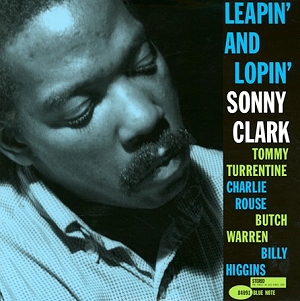
Jimmy Smith played a Hammond B3 organ, and in such a case, a band didn’t absolutely require a bassist, because the organ has pedals for the low notes. In this quartet, Smith was on the B3, Stanley Turrentine played tenor sax, Kenny Burrell was on guitar, and Donald Bailey handled the percussion. Very deep bass, which an organ can produce, is difficult for an LP because the grooves would have to be very wide. The RIAA pre-emphasis curve attenuates the bass so the grooves are narrow. In fact, the RIAA curve is designed so that the grooves for all frequencies are the same width (assuming they are at the same volume). The pedal tones shook the room, which proved the worthiness of the MPS-2 power supply and the BP-1.5’s frequency response.
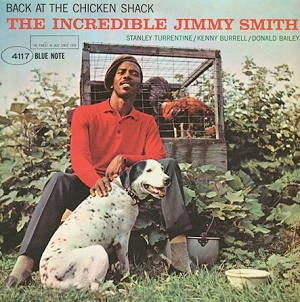
Speaking of which, the measured frequency response of the BP-1.5, using RIAA pre-emphasis EQ, is shown below. It is flat out to 5 kHz, then rolls off slowly to be down 1 dB at 20 kHz. This slight roll off may contribute to the BP-1.5’s smooth, easy to listen to, sound. Many classic LP’s, even though they were remastered for today’s market, were poorly recorded, having a harsh sound. The BP-1.5 didn’t impart that harshness at all.
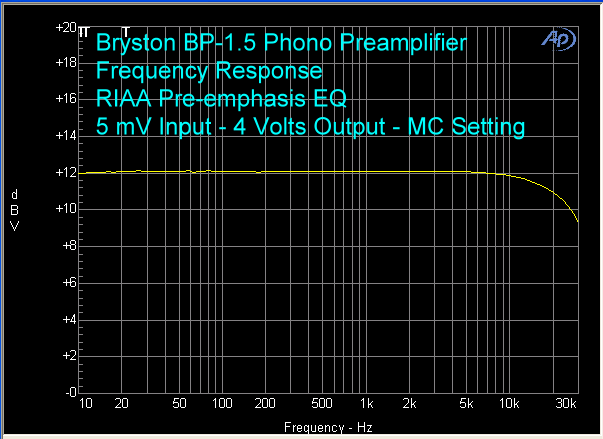
When I measured THD+N, it changed depending on how the input cables were positioned (cables from the phono cartridge to the phono preamp). This is because one is dealing with such low signal levels, just about anything electrical that is nearby, and also what else is going on electrically in your house – maybe even your neighbor’s house – is enough to cause noise levels to change when you rearrange the cable placement. So, I just measured it with the cables here and the cables there, and the cables over the top, etc., etc. The result is that the BP-1.5 meets its low distortion specification, and I am again reminded of how careful you have to be in placing the cables between your turntable and the phono preamplifier.
Conclusions
My overall impression of the Bryston BP-1.5 is that it is very neutral and very clean. There is no particular range of frequencies, such as the lows, mids, or highs, that are in your face. It is extremely smooth and easy to listen to. It is also quiet. I could not detect hiss or hum (a phono preamp after all is dealing with amplification of very small voltages, and if it is not laid out properly, hiss and/or hum will work its way into the sound).
It’s a terrific product and well worth the price, especially if you already have a Bryston component with the MPS-2 power supply.



